In this conversation, Berlin based artist Tobias Zimmer discusses his algorithmic art by tracing back to experimental and digital works from 2013. Through an insight into his experimental, design, and programmed methods of investigation, the artist dwells on the potential that techno-sciences bring into artistic discourse.
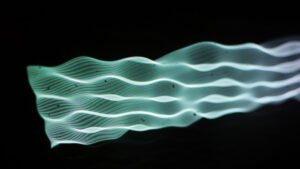
Tobias Zimmer, Waves³, experimental photo series, 2013, courtesy the artist
Sara Buoso: Your experimental photo work, Waves³, 2013, addresses an interesting contribution to the visualization of the phenomenon of the entanglement of light through a practice that sits between arts and techno-sciences. Would you like to talk about the process beyond this work?
Tobias Zimmer: I developed Waves³ when I began to study Intermedia Design at the University of Applied Sciences in Trier. It was part of an exhibition on the topic of unrest. Walking along the river nearby the university, I started to notice the moving shapes of sun light reflecting from the water surface – an optical effect known as caustics. In the beginning I naively felt that I’ve witnessed a completely new natural phenomenon, but of course it exists since there is light and reflective surfaces. At that time, I was also interested in sound reactive visuals, mainly from a programming perspective and I wanted to find an analogue transfer, in combination with my fascination for caustics. That’s why I built an artificial caustics setup. I placed a loudspeaker beneath a water basin and used a small projector as a light source, which was directed at the water surface, reflecting the light onto a projection screen. I played a low sine frequency on the speaker, which set the water into vibration, forming a standing wave that mirrored the frequency of the sound. The initially straight line of reflected light is distorted by the oscillating water surface. Finally, I photographed the resulting projection with very short exposure times, to capture singular waves, instead of multiple ones superimposing each other. This way the photographs cut out slices of caustic chaos and show something that is not perceivable with the bare eye.
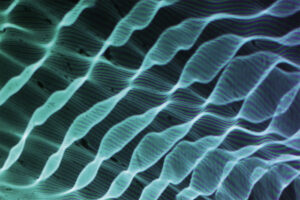
Tobias Zimmer, Waves³, experimental photo series, 2013, courtesy the artist
You reference the work Notion Motion, 2005, by Olafur Eliasson. But since you describe your work as a ‘visual experimentation’, this reminds me of experiments within the field of quantum mechanics and quantum physics like the Schrödinger’s Cat experiment for example.
Waves³ might recall the setup of a physics experiment on interference, that shows how two waves in a water basin interact with each other, after passing through two slits. It is always shown in reference to the famous double slit experiment in quantum physics, which proved that light can be perceived as both waves and particles on a quantum scale. I wouldn’t say that my work is touching upon this experiment. Also Schrödinger’s Cat is a pure thought experiment and in Waves³ I was only interested in audio-visual effects. However, the particle/wave dualism, as shown by the double slit experiment, is interesting to me since my high school physics classes. Especially as its results defy our common sense and it is so hard to imagine that on a quantum scale, elements take on different behaviors, depending on how you measure them. It opens up the question if there is an objective reality at all, or if we as observers define the world by deciding on how we look at it.
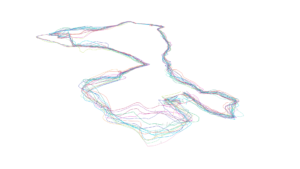
Tobias Zimmer, Identical Walk, Virtual Walking, performance and generative art, 2021, courtesy the artist
What about other works that involve a practice of light?
As I mostly work visually, of course all my works involve light (laughing). In a research project in a glass blowing studio, I created glass objects with random processes, that I used as experimental lenses to distort light and drawings. The caustic effects look like pure magic, and they are as fascinating to me as they are cheesy. I had the feeling that I had to purge the objects of their magic and bring order into the caustic chaos. Recently, I’ve been working with 3D computer graphics and ray tracing, which are digitally simulating light with the laws of physics. With this, it would be possible to achieve that “purge” algorithmically and then create real world objects from the simulation. Starting with a computer simulation fits my research based way of working really well, but it’s always important for me to end up in the physical world again.
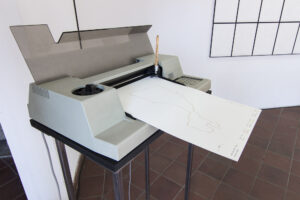
Tobias Zimmer, Identical Walk, Walking Document, performance and generative art, 2021, courtesy the artist
You mention a metrics and design approach to rescale and measure technology. Now your artistic research focuses on algorithmic art. Can you tell us a little bit more about this practice?
Algorithmic art has its roots in the 1960’s, when a few artists and technologists began to work with programming and computers, using pen plotters for graphical output. Also some works by the Fluxus movement and concept artists at that time can be seen as algorithmic. Nowadays we are surrounded by computer technology and algorithms that are integrated into our lives down to the body level. But it is not only wearable computing or the smartphone – the way people organize their lives by writing to do lists and repeating routines or even when they use a recipe to bake a cake, they are following an algorithm. I program my own artistic software and try to experience algorithmic paradigms on my own body. By displaying the results, I want to show how internalized algorithmic thinking has an influence on our life. In my work Identical Walk (2021), a performance and generative exhibition, I took twentyone walks, starting each day from the gallery – at the same time, on the same route, with exactly the same steps. For this purpose, I built a device, the Pacemaker, which recorded my steps via microphones. The audio recording was played back via loudspeakers during the next days walk, as a guide for my steps to follow. At the same time the data collected during the walk, generated the objects in the exhibition. I wanted to experience what it means to fully submit to an algorithm that I created for myself. Does it provide a feeling of stability and control, or does it lead to stagnation in an endless repetition? Do I engage in a mindful walking meditation or am I following a misguided promise of performance through self-optimization?
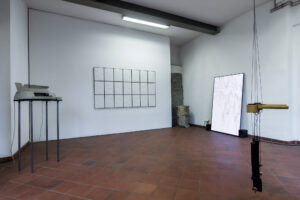
Tobias Zimmer, Identical Walk, Exhibition View, performance and generative art, 2021, courtesy the artist
In this sense, algorithmic art questions the boundaries between chance and control, freedom, and power.
Chance and randomness are often used in algorithmic art to introduce variety into strict programmed order. This was also part of an artistic programming class I taught at Bauhaus University Weimar. I alternated class homework between writing simple computer programs in the language Processing and writing algorithms for fellow students with natural language – both generating visual output. I was interested to use the human mind as a graphical processor, in a similar way as the programming language is using the computer processor. As a reference, starting in the 1960’s, the artist Sol LeWitt wrote simple instructions that were executed by other people, resulting in his famous wall drawings. Although Sol LeWitt probably didn’t see it this way, I think it can be understood as programming other humans. In my class it was interesting to see, that when you write algorithms for people, you have to learn to put yourself in the perspective of the person executing it and what it means to give exact instructions. When you program a computer, there is no room for vague commands. If you make a mistake, your program doesn’t work at all. (However, this is changing with AI tools like GPT, that can program for you upon natural language prompts). Humans on the other hand are able to interpret unspecific instructions. If you are vague with your wording, you might be surprised to receive results different from what you had in mind. By learning to program, writing instructions for other humans and executing such instructions yourself, you experience another way of thinking. Algorithmic art always means thinking with the other in mind, be it computers, humans or other entities.
Info:
www.tobiaszimmer.net

She is interested in the visual, verbal and textual aspects of the Modern Contemporary Arts. From historical-artistic studies at the Cà Foscari University, Venice, she has specialized in teaching and curatorial practice at the IED, Rome, and Christie’s London. The field of her research activity focuses on the theme of Light from the 1950s to current times, ontologically considering artistic, phenomenological and visual innovation aspects.






NO COMMENT